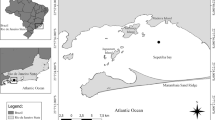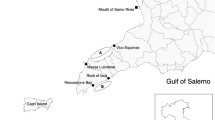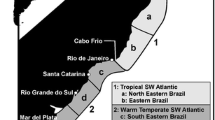Abstract
The spatial distribution of parasite communities from teleost fishes (Diplodus vulgaris, Mullus surmuletus, Pagellus erythrinus, Phycis phycis, Scorpaena scrofa and Symphodus tinca) was studied in the Bonifacio Strait Marine Reserve (Corsica Island) with different protection levels. Canonical correspondence analysis was used to study spatial patterns and to quantify the importance of site influence on parasite communities. To supplement these results, we used the indicator species analysis (Indval) to identify parasite species as bioindicators of a given ecosystem. Moreover, fish spatial distribution in the marine reserve was evaluated in order to link parasite species occurrence and fish abundance. Several parasite species were associated with a specific site, and some of them were considered as site bioindicators, especially in the western part of the protected area (Bruzzi and Moines Islands). However, the relative abundance of fish followed a different spatial pattern. Stronger fish abundance was observed in the eastern part of the reserve (Lavezzi Islands). The parasite species were correlated to sites inside as well outside the reserve. The parasite distribution seemed not to be influenced by the protection status of the site. Furthermore, in our study, most of the parasite species were not linked to a site. The most important factor influencing their distribution was host specificity. This suggested that the parasite life traits history remained a fundamental determinant in the community composition.


Similar content being viewed by others
References
Adlard RD, Lester RJG (1994) Dynamics of the interaction between the parasitic isopod, Anilocra pomacentri, and the coral reef fish, Chromis nitida. Parasitology 109:311–324
Anderson MJ, Gribble NA (1998) Partitioning the variation among spatial, temporal and environmental components in a multivariate data set. Aust J Ecol 23:158–167
Bauchot ML, Pras A (1980) Guide des poissons marins d’Europe. Delachaux et Niestlé. Neuchâtel, Paris
Bell JD (1983) Effects of depth and marine reserve fishing restriction on the structure of the rocky reef fish assemblage in the North Western Mediterranean sea. J Appl Ecol 20:357–369
Borcard D, Legendre P, Drapeau P (1992) Partialling out the spatial component of ecological variation. Ecology 73:1045–1055
Bray RA, Gibson DI, Jones A (2008) Keys to the Trematoda, vol III (edited by DI Gibson, A Jones, RA Bray). Wallingford, UK and The Natural History Museum, London
Brooks DR, McLennan DA (1991) Phylogeny, ecology and behavior: a research programm in comparative biology. The University of Chicago Press, London
Chapman MR, Kramer DL (1999) Gradients in coral reef fish density and size across the Barbados Marine Reserve boundary: effects of reserve protection and habitat characteristics. Mar Ecol Prog Ser 181:81–96
Cribb TH, Anderson GR, Dove ADM (2000) Pomphorhynchus heronensis and restricted movement of Lutjanus carponotatus on the Great Barrier Reef. J Helminthol 74:53–56
Desdevises Y, Morand S, Jousson O, Legendre P (2002) Coevolution between Lamellodiscus (Monogenea) and Sparidae (Teleostei): the study of a complex host–parasite system. Evolution 56:2459–2471
Dufour V, Jouvenel J-Y, Galzin R (1995) Study of a Mediterranean reef fish assemblage. Comparisons of population distributions between depths in protected and unprotected areas over one decade. Aqua Living Resour 8:17–25
Dufrêne M, Legendre P (1997) Species assemblages and indicator species: the need for a flexible approach. Ecol Monogr 67:345–366
Gibson DI, Jones A, Bray RA (2002) Keys to the Trematoda, vol I (edited by DI Gibson, A Jones, RA Bray). Wallingford, UK and The Natural History Museum, London
Grutter AS (1998) Habitat-related differences in the abundance of parasites from a coral reef fish : an indication of the movement patterns of Hemigymnus melapterus. J Fish Biol 53:49–57
Guégan J-F, Morand S (1996) Polypoid hosts: strange attractors for parasites! Oikos 7:366–370
Guidetti P, Fanelli G, Fraschetti S, Terlizzi A, Boero F (2002) Coastal fish indicate human-induced changes in the Mediterranean littoral. Mar Environ Res 53:77–94
Haggarty DR, King JR (2006) CPUE as an index of relative abundance for nearshore reef fishes. Fish Res 81:89–93
Holmes JC, Price PW (1980) Parasites communities: the roles of phylogeny and ecology. Syst Zool 29:203–213
Jones CM, Grutter AS (2007) Variation in emergence of parasitic and predatory isopods among habitats at Lizard Island, Great Barrier Reef. Mar Biol 150:919–927
Jones A, Bray RA, Gibson DI (2005) Keys to the Trematoda, vol II (edited by A Jones, RA Bray, DI Gibson). Wallingford, UK and The Natural History Museum, London
Kadlec D, Šimková A, Jarkosvký J, Gelnar M (2003) Parasite communities of freshwater fish under flood conditions. Parasitol Res 89:272–283
LaMesa G, Vacchi M (1999) An analysis of the coastal fish assemblage of the Ustica Island marine reserve (Mediterranean Sea). Mar Ecol 20:147–165
Legendre P, Legendre L (1998) Numerical ecology. Elsevier, Amsterdam
Lepš J, Šmilauer P (2003) Multivariate analysis of ecological data using CANOCO. Cambridge University Press, Cambridge
Manter HW (1967) Some aspects of the geographical distribution of parasites. J Parasitol 53:3–9
McCune B, Mefford MJ (1999) PC-ORD. Multivariate analysis of ecological data. Version 4.0. MjM Software, Gleneden Beach, Oregon, USA
Miniconi R (1994) Les poissons et la pêche en Méditerranée : la Corse. Alain Piazzola & La Marge
Mouillot D, Culioli J-M (2002) The sample size necessary to assess changes in fish biomass: a reply. Mar Ecol 23:11–18
Mouillot D, Culioli J-M, Lepêtre A, Tomasini JA (1999) Dispersion statistics and sample size estimates for three fish species (Symphodus ocellatus, Serranus scriba and Diplodus annularis) in the Lavezzi Islands Marine Reserve (South Corsica, Mediterranean Sea). Mar Ecol 20:19–34
Mouillot D, Culioli J-M, Do Chi T (2002) Indicator species analysis as a test of non-random distribution of species in the context of marine protected areas. Environ Conserv 29:385–390
Petter AJ, Radujkovic BM (1989) Parasites des poissons marins du Monténégro: Nématodes. Acta Adriat 30:195–236
Polunin NVC, Roberts CM (1993) Greater biomass and value of target coral reef fishes in two small Caribbean marine reserves. Mar Ecol Prog Ser 100:167–176
Poulin R (1995) Phylogeny, ecology, and the richness of parasite communities in vertebrates. Ecol Monogr 65:283–302
Poulin R, Mouillot D (2003) Parasite specialization from a phylogenetic perspective: a new index of host specificity. Parasitology 126:473–480
Poulin R, Rohde K (1997) Comparing the richness of metazoan ectoparasite communities of marine fishes : controlling for host phylogeny. Oecologia 110:278–283
Radujkovic BM (1989) Parasites des poissons marins du Monténégro: Acanthocéphales. Acta Adriat 30:189–194
Radujkovic BM, Euzet L (1989) Parasites des poissons marins du Monténégro: Monogènes. Acta Adriat 30:51–135
Radujkovic BM, Raibaut A (1989) Parasites des poissons marins du Monténégro: Copépodes. Acta Adriat 30:237–278
Rigby MC, Holmes JC, Cribb TH, Morand S (1997) Patterns of species diversity in the gastrointestinal helminths of a coral reef fish, Epinephelus merra (Serranidae), from French Polynesia and the South Pacific Ocean. Can J Zool 75:1818–1827
Roberts CM, Polunin NVC (1991) Are marine reserves effective in management of reef fisheries? Rev Fish Biol Fish 1:65–91
Roberts CM, Bohnsack JA, Gell F, Hawkins JP, Goodridge R (2001) Effects of marine reserves on adjacent fisheries. Science 294:1920–1923
Rohde K (2002) Ecology and biogeography of marine parasites. Adv Mar Biol 43:1–86
Sasal P, Faliex E, Morand S (1996) Parasitism of Gobius bucchichii Steindachner, 1870 (Teleostei, Gobiidae) in protected and unprotected marine environments. J Wildl Dis 32:607–613
Sasal P, Morand S, Guégan JF (1997) Determinants of parasite species richness in Mediterranean marine fishes. Mar Ecol Prog Ser 149:61–71
Sasal P, Niquil N, Bartoli P (1999) Community structure of digenean parasites of sparid and labrid fishes of the Mediterranean sea: a new approach. Parasitology 119:635–648
Sasal P, Desdevises Y, Durieux E, Lenfant P, Romans P (2004) Parasites in marine protected areas: success and specificity of monogeneans. J Fish Biol 64:370–379
Sousa WP (1994) Patterns and processes in communities of helminth parasites. Trends Ecol Evol 9:52–57
ter Braak CJF (1986) Canonical correspondence analysis: a new eigenvector technique for multivariate direct gradient analysis. Ecology 67:1167–1179
ter Braak CJF, Šmilauer P (1998) CANOCO reference manual and user’s guide to CANOCO for Windows: Software for Canonical Community Ordination (version 4). Microcomputer Power, Ithaca, New York, USA
Trilles JP, Radujkovic BM, Romestand B (1989) Parasites des poissons marins du Monténégro: Isopodes. Acta Adriat 30:279–306
Acknowledgements
This study was technically supported, for fish collecting, by the Bonifacio Strait Marine Reserve fishermen and managers. We express our thanks to Robert Poulin and Francesco de Bello for their helpful comments on the draft of this paper.
Author information
Authors and Affiliations
Corresponding author
Rights and permissions
About this article
Cite this article
Ternengo, S., Levron, C., Mouillot, D. et al. Site influence in parasite distribution from fishes of the Bonifacio Strait Marine Reserve (Corsica Island, Mediterranean Sea). Parasitol Res 104, 1279–1287 (2009). https://doi.org/10.1007/s00436-008-1323-7
Received:
Accepted:
Published:
Issue Date:
DOI: https://doi.org/10.1007/s00436-008-1323-7




